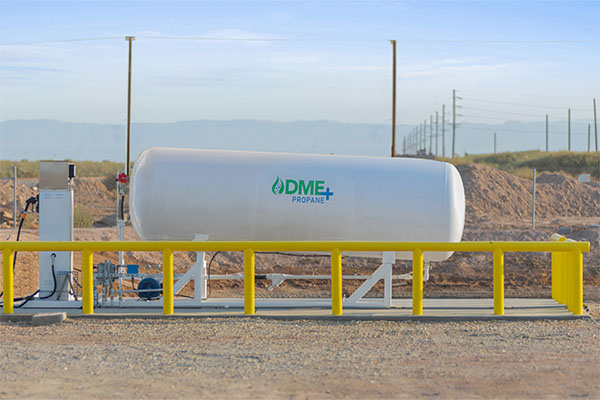LPG leaders plan commercialization of rDME and propane blends
Dimethyl ether (DME) isn’t a new molecule, but its renewable counterpart rDME has gained the attention of LPG leaders for its potential to help decarbonize the LPG industry.

Oberon Fuels has partnered with Suburban Propane to offer commercial low-carbon rDME and propane blends. (Photo courtesy of Oberon Fuels)
Last summer, Oberon Fuels of San Diego began production of the first-ever rDME in the U.S. and the only current commercial production of the molecule in the world, according to the company. It is expected to reach nameplate capacity in the early part of this year.
Suburban Propane Partners purchased a 39 percent stake in Oberon Fuels and committed to provide additional funding to support development efforts to begin commercializing a propane and rDME blended product.
Michael Stivala, president and CEO of Suburban Propane, considers rDME and its suitability for LPG blends a “game-changer for our industry.”
Stivala shared his view on a panel about rDME during the World LPG Association’s LPG Week.
Suburban Propane and Oberon Fuels are working to apply the technical and regulatory requirements that govern the storage and distribution of propane in the U.S. – such as labeling, ASTM standards and safety data sheets – to blended products.
Suburban Propane is also approaching its customers, starting in the transportation and forklift markets, to develop demand for a blended product.
Early indications suggest customers are excited by the potential, says Stivala: “They don’t have to change out all of their equipment to try to decarbonize by transferring over to electrification, and so it’s meeting the needs of our customers with a product that we know best.”
Fellow panelists Bram Gräber, CEO of SHV Energy, and Roger Perreault, president and CEO of UGI, say rDME is one of several paths to decarbonization in which they are investing. SHV Energy and UGI own equal stakes in a joint venture that will invest in rDME production this year, initially in the U.K. and thereafter in the U.S.
More to accomplish
While enthusiastic at this early stage of market development, panelists outlined work that still needs to be done before rDME demonstrably contributes to decarbonization in the LPG industry.
The carbon intensity of rDME and propane blends can vary depending on the rDME feedstock, production process and blend percentages.
Many kinds of organic waste qualify as feedstock for rDME, including biogas from dairy waste, food waste and agricultural waste.
Producing rDME from dairy biogas using the Oberon process would yield a particularly low carbon intensity value of -278, according to estimates by the California Air Resources Board. Oberon Fuels currently produces rDME with waste methanol from pulp mills.
Panelists agree that, unlike other renewable molecules, feedstock for rDME is plentiful.
Based on experience in the renewable natural gas space, however, Perreault of UGI anticipates increased competition for feedstock as capital enters the space. He cautions the industry to position itself early to direct desired feedstocks toward rDME production.
Blend percentages also challenge producers’ efforts to earn a renewable designation cost effectively, using existing infrastructure and equipment. According to the International DME Association, blends of up to 20 percent rDME can be used without modifying existing LPG appliances, storage tanks or equipment.
Suburban Propane is testing a blend of 4 percent rDME using its own infrastructure, bobtails and cylinders in a controlled setting before delivering it to customers, and is seeking pathways to reach the 20 percent rDME benchmark, explains Stivala.
Part of Suburban’s strategy, says Stivala, is to generate excitement about the carbon reduction potential to establish a demand base, and then encourage equipment manufacturers to assist with testing higher blend percentages.
“The challenge,” he says, “is getting market development to follow quickly enough to deliver the product to our customer, which is somewhat dependent on, say, the engine manufacturers to help us evaluate and test higher blend percentages with rDME and propane because, the higher the blend, the higher the impact on carbon reduction.”
Illustration: wildpixel/iStock / Getty Images Plus/Getty Images
















